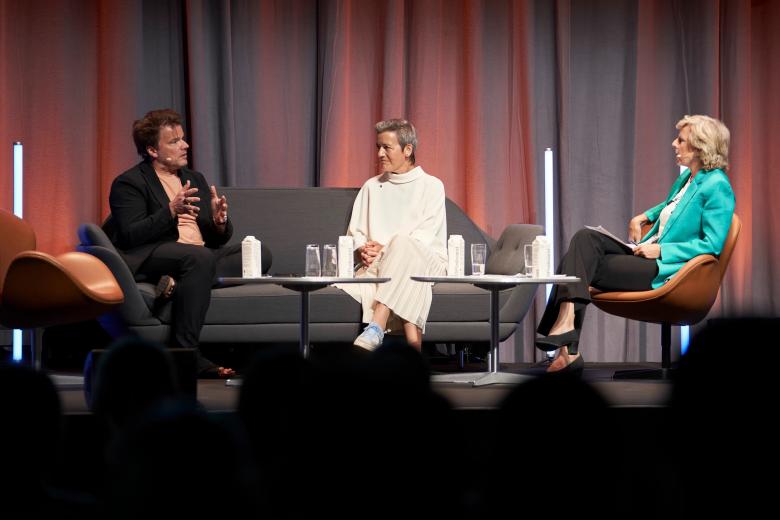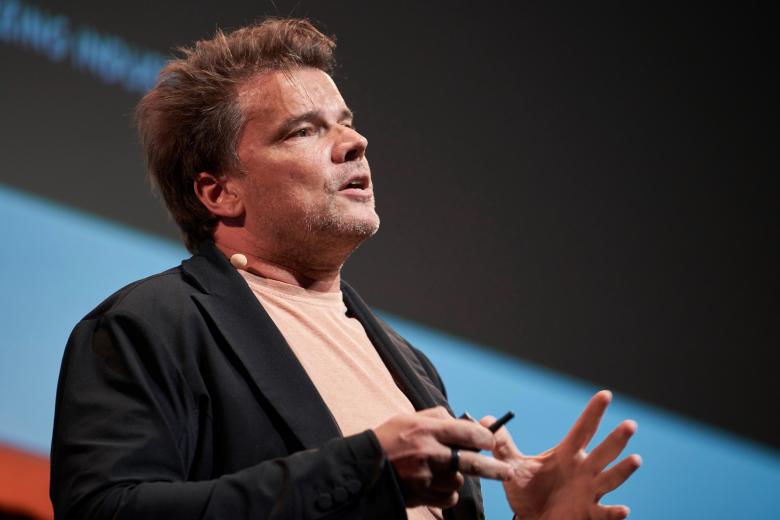UIA World Congress of Architects 2023
Margrethe Vestager: 'We have great ambitions, but we are nothing without the people'
The challenge of rethinking our built and future environment is a global one. Politician Margrethe Vestager and architect Bjarke Ingels engaged in a conversation on a UIA panel about the responsibility shared by all stakeholders in the construction industry, policymakers, and the general population to contribute significantly to the success of the energy transition in the building sector.
In 2015, the member states of the United Nations established seventeen goals that aim to achieve significant progress by 2030 in terms of sustainable development, environmental protection, and social justice. The European continuation came in December 2019 when the European Commission, under Ursula von der Leyen, adopted the European Green Deal, which, if implemented, could enable the EU to achieve net-zero greenhouse gas emissions by 2050. The EU's climate policy also focuses on how the community of nations can achieve a resource-efficient and competitive economy. The cultural initiative New European Bauhaus, also launched by the European Commission, complements this endeavor at the national level and aims to expand the environmental and economic project of the European Green Deal into a European cultural project.
In order to translate theoretical approaches and best intentions into practice, it requires dialogue and direct exchange between architects and experts from the fields of science, business, and politics, instead of allowing everyone to operate within their respective isolated “silos.” The keynote dialogues at the UIA Congress in Copenhagen provided a significant platform for exactly this idea. Connie Hedegaard, as the moderator, guided all the talks with aplomb, and one could always sense her background knowledge and awareness of the issues as a journalist and former EU Commissioner for Climate Action. The first exchange of this kind brought together Danish politician and EU Commissioner Margrethe Vestager and Danish architect Bjarke Ingels. They discussed, among other things, how these meaningful approaches to new construction can gain greater awareness among politicians, the business sector, and the general public.
“Today, you have roughly a billion people living in informal settlements, and by 2050 that number will probably be 2.3 billion. So, you have to think in a scalable market model. One of the things that have had the biggest impact on life in these informal settlements is the availability of cheap corrugated sheet metal [to build the shelters]. But how about panels with integrated PV solutions? Or dehumidifiers that could produce drinkable clean water? This an interesting market, because two and a half billion people — a quarter of the earth's population — will be living in these unplanned communities.”
Ingels expressed the need to make sustainable alternatives more attractive by alleviating users' hesitations. If there were a series of "first movers" who try out new concepts and create reference buildings, skepticism would diminish. As an example, he mentioned one of his own projects: BIG is constructing its new headquarters in the north of Copenhagen, using a novel concrete/clay mixture that reduces the building's carbon footprint. Although this project could serve as a built prototype for the future, all experimental series and ideas for prototypes are faced with the urgency to act quickly to curb CO2 emissions and embrace new construction methods — the timeframe is limited. Moreover, this transformation in the (construction) industry represents the first global transition that is politically motivated, politically decided.
"So, there is a chance for more to happen," said Vestager. “You need a combination of regulation, of funding, and you have to invest a bit more now to prevent further costs in the future.” Everyone would have to get used to the fact that these investments will only pay off much later. But how realistic is this and are investors prepared not only to think outside the box but also to opt for sustainable alternatives and building materials when these are often associated with additional costs and less profit? Ingels put it into perspective: If you want to hold an asset in the long term, you actually have an incentive. In addition, digital tools have become available today that earlier generations didn't have. “Now we have relatively sophisticated modeling to show the life cycle of buildings over the next decades,” explained the architect. Moreover, in the digital age, we actually have that overview of everything at the same time, making it possible and even feasible to monitor and account for initiatives at a global scale.
This overarching, informed approach can also be applied to the building sector, as Vestager said: “As soon as emission-related costs are no longer outside our spreadsheet but are a cost on your building, all of a sudden these design choices have a value, and they have that value today because you know what is the price that you're going to pay. And I think that is a very tangible way of taking externalities and putting a price tag on them, so that all of a sudden it's a much more obvious choice to go with what is long-term sustainable.”
“Part of the point is that it's not possible to plan everything. We do not have the time to plan everything. Instead we need much more decentralized systems. If we systemically can provide a sort of a planetary approach to renewable energy, we are also giving people the choice to live and to build and to renovate sustainably. I think architects as change agents play a crucial role to say, ‘This is how it can happen.’”
Of course, this also applies to the immense building stock that can be renovated and repurposed. There are still too many new buildings using standardized construction elements from mass production that do not contribute to circular building. Today, however, we know that recycling, reuse, and renovation are key cornerstones on the path to the energy transition in the building sector as well. Ingels feels that the emotional connection between people and buildings is particularly important, because it creates reliability and people take good care of the buildings they inhabit: “In our urban environment, it's probably a good idea to spend a little bit of extra time and energy on making projects thoughtful, generous, and enjoyable because then people will actually take care of them.”
Asked for a brief closing statement, they both got to the point again: To some degree, humans, according to Vestager, like to be part of creating something new and all want to connect with history. However, creating something new does not mean producing something new — reuse also creates something new in a different context. And Ingels concluded that, while architecture can be a safe space when designing cultural buildings, “architects have to apply their creative holistic mindset to industry, agriculture, the energy sector, and infrastructure to a greater extent, and not leave all the hard problems to the engineers to solve.”


